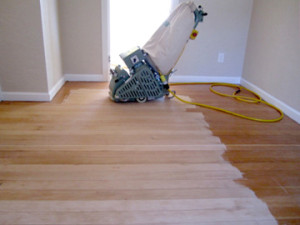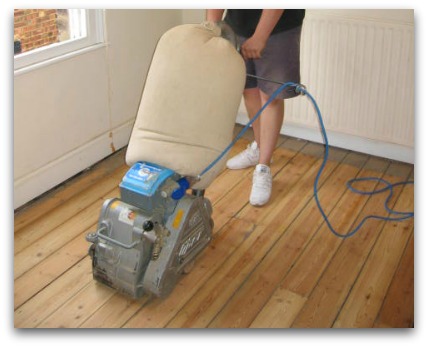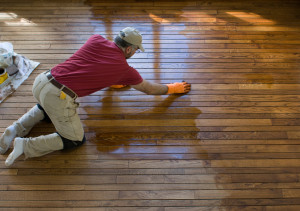 An important part of resurfacing or refinishing an existing hardwood floor is sanding. A professional sanded floor can add immense value to an old floor. Hardwood Floor Sanders can remove gouges and scratches, bring out the true beauty of your floors, and also allows you to change the stain if you wish to enhance the floor. This is work that can be completed by the average person.
An important part of resurfacing or refinishing an existing hardwood floor is sanding. A professional sanded floor can add immense value to an old floor. Hardwood Floor Sanders can remove gouges and scratches, bring out the true beauty of your floors, and also allows you to change the stain if you wish to enhance the floor. This is work that can be completed by the average person.
Provided that you take the time to learn the proper way to sand a floor and also use the right equipment. If you make a mistake and ruin your floor it can be very expensive and depending how bad the mistake is, you might even have to replace the flooring with new flooring. Take your time, learn what you need to know and talk to experts. Experiment on a small area first to make sure that you have the proper procedure nailed down. Select an area that is out of the way and perhaps hidden by furniture.
Sanding is needed
Sanding is necessary to remove water marks and other damage that may have occurred on the floor. When you have large surfaces to cover, a hardwood floor sander is the only way to refinish a hard wood floor. We have gathered some information regarding hardwood floor sanders along with some tips on their operation for those interested in taking on the task. Sanding the floors yourself can also save the consumer a lot of money, however care is need to make sure it is done correctly or you could actually ruin the floor completely.
Hardwood floor sanders come in many shapes and forms and each will perform their task in a different way. There are drum sanders, belt sanders, orbital sanders and disc sanders. Along with this there are still edge sanders to deal with not to mention the sand paper itself.
These machines are helpful tools when used properly, however if placed in the hands on someone lacking experience they can cause a lot of damage with expensive repairs required.
Hardwood Floor Sanders
Drum Sander
The most common of all the hardwood floor sanders is the drum sander. These sanders are meant to get right down to the bare wood and they do a good job. One problem with the power of drum sanders is that if you are not careful you can sand a groove in your floor. This means you should have some previous experience with the machine. Experiment first before you try it out on your expensive hardwood floor. It is a good idea to take a scrap piece of wood and try it before moving to the real floor.
Remember to use these sanders in the direction of the wood grain. This is also very important. Sanding across the wood grain will leave scratches that the stain and verathane will enhance leaving you with a non professional looking floor.
Belt Sanders
Belt Sanders are the next most seen of the hardwood floor sanders and are somewhat easier to use. These sanders do however require control and strength in order to do the job well.
Other Hardwood Floor Sanders
Orbital Sanders and disc sanders are more suitable for small jobs or for sanding specific areas. These however are known for their tendency to leave circular marks in the floor.
With hardwood floor sanders, everything comes down to what you feel comfortable with and what you are capable of handling. Gaining experience before you use the sanders on your floors is highly recommended. A good sanding job will revive your floors and add value to your home. Some of the larger chain stores will offer training courses from time to time on the use of equipment. These are definitely worth the time and you can then approach the job with more confidence.


 before refinishing the hardwood floor by removing everything inside including vents and grills. Remove all furniture and then cover doorways and vents with plastic sheeting.The fine dust from the sanding activity is going to go everywhere. Plugging the vents etc is a must unless you want dust everywhere. Also if you have central air conditioning or central heating, make sure it is turned off. Otherwise you will have dust in every nook and cranny of your home. You will be cleaning for months.
before refinishing the hardwood floor by removing everything inside including vents and grills. Remove all furniture and then cover doorways and vents with plastic sheeting.The fine dust from the sanding activity is going to go everywhere. Plugging the vents etc is a must unless you want dust everywhere. Also if you have central air conditioning or central heating, make sure it is turned off. Otherwise you will have dust in every nook and cranny of your home. You will be cleaning for months. the coarsest paper (36 grit) and moving to finer paper sequentially (36, 60, 80, 100). Take your time and never sand across the grain. If you sand across the grain, you may leave scratches on the wood that cannot be removed. Repeat this with the edge sander until you are satisfied with the look.
the coarsest paper (36 grit) and moving to finer paper sequentially (36, 60, 80, 100). Take your time and never sand across the grain. If you sand across the grain, you may leave scratches on the wood that cannot be removed. Repeat this with the edge sander until you are satisfied with the look. the fine bits of dust that may be left on the floor. Apply the stain in even strokes along the grain with a brush for darker color, or rags for a lighter look. Ensure you have proper ventilation to avoid damage to your lungs.
the fine bits of dust that may be left on the floor. Apply the stain in even strokes along the grain with a brush for darker color, or rags for a lighter look. Ensure you have proper ventilation to avoid damage to your lungs.